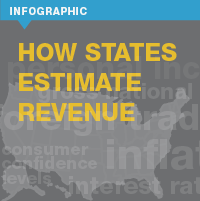Sarah Emmans States Revenue Spending

Sarah McLaughlin Emmans, Research Manager, Pew Center on the States

A number of states have seen tax collections come in below forecasts in recent months as the nation continues to struggle with a weakening economic outlook. High unemployment, a struggling housing market, weak consumer confidence and global worries such as the European debt crisis all complicate states’ ability to forecast their revenue, according to this infographic from Pew Center on the States.
Errors in estimating revenues can leave policy makers unsure about how much revenue their states will have coming in, making it tougher for them to make thoughtful decisions about where to spend and where to cut. Sarah McLaughlin Emmans, research manager with Pew Center on the States, explains the process states use to forecast revenue, discusses the challenges that they continue to face, and outlines measures some states have used to improve accuracy.
Q: How do states estimate how much tax revenue they will collect?
Most states purchase national economic data (GDP, employment, inflation, consumer spending patterns, and other indicators) and translate those statistics into state-specific numbers. Then they feed the information into a computer model that uses current tax rates and data from past years to predict future collections. Governors use the resulting estimates in crafting their budget proposals, which they send to legislators in the fall or winter. Some states update their revenue projections during the course of the budget debate.
Q: What are the stakes in getting these predictions right?
A: States have already closed more than $500 billion in budget shortfalls over the past five years, due to less revenue coming in than expected. At a time when it’s important for states to get it right, they’re still having difficulty with their forecasts. When they face a shortfall, they either have to make cuts or increase taxes, and that is an unwanted surprise, especially as our economy continues to struggle.
Q: Recently, several states have had to lower their revenue forecasts, while others have enjoyed unexpected surpluses. How reliable are revenue estimates?
A: Most revenue estimates are built on assumptions of economic growth, so tumultuous times like these can produce forecasts that end up being much too high or low. We found that during each of the last three downturns, more states made errors—and the errors were getting bigger. Last year, for example, Louisiana collected 10 percent more in income taxes than it had predicted. Two years ago the state collected 26 percent less than it had anticipated.
States also have to deal with a number of factors completely out of their control. After the earthquake and tsunami in Japan, for example, Washington State lowered its revenue estimate because it relies heavily on trade with that country.
Q: What can states do to improve the accuracy of their estimates?
A: Some states, such as Vermont and Florida, increased the frequency of their estimates during the downturn because economic conditions were deteriorating so rapidly. Other states have revised their revenue models to reflect changing economic realities. In Michigan, for example, officials no longer expect so much from the state’s shrinking auto industry.
Q: How are state revenues doing now—and what does the future hold?
A: Many state budget directors and revenue estimators have said they are "cautiously optimistic" that tax collections will continue to improve. States’ revenues have grown for six straight quarters, but collectively they are still 7 percent below pre-recession levels; on a state-by-state basis, 25 states are at least 10 percent below their peak.
For more information on the challenges states face in estimating revenue, read our full report.







